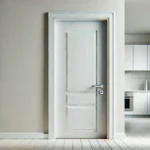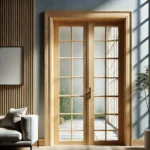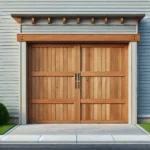Front doors hold a unique place in architecture and home design, acting as the primary gateway to a property. They are not just functional components but also significant contributors to a home’s overall aesthetic and character. A well-chosen front door makes a strong first impression, enhancing curb appeal while providing security and functionality. With the perfect blend of style, durability, and practicality, front doors serve as both a statement piece and a critical element of any building’s design.
The front door is often the first detail visitors notice, setting the tone for the rest of the property. It acts as a welcoming feature, guiding guests into the home while reflecting the personality and taste of the homeowner. The choice of material, color, and design can say a lot about the style and character of a property, whether it’s a traditional residence, a contemporary structure, or a rustic retreat. For this reason, the front door is often considered a focal point of the home’s exterior.
Security is a fundamental role of front doors, as they are the primary barrier between the interior and the outside world. Modern front doors are designed with advanced security features to protect the occupants and their belongings. Solid materials such as wood, steel, and fiberglass are commonly used to provide strength and durability. Many front doors also come equipped with features like reinforced frames, multi-point locking systems, and smart locks that enhance safety while offering convenience.
Energy efficiency is another essential aspect of front doors. A high-quality front door contributes to the thermal insulation of a home, helping to maintain a comfortable indoor temperature and reducing energy costs. Insulated cores, weatherproof seals, and energy-efficient glazing are some of the features that improve the door’s ability to minimize heat loss in winter and heat gain in summer. These features are particularly valuable in climates with extreme temperatures, as they enhance the comfort of the home while lowering utility bills.
The material of a front door plays a significant role in its overall performance and appearance. Wooden front doors are a classic choice, offering timeless beauty and a warm, natural aesthetic. They can be customized with various stains, paints, and finishes to suit different architectural styles. However, wood requires regular maintenance to protect against moisture, warping, and insect damage. Steel front doors, on the other hand, are highly durable and offer excellent security. They are resistant to cracking and warping, making them a practical option for homeowners seeking low-maintenance solutions.
Fiberglass front doors have gained popularity due to their versatility and resilience. They can mimic the look of wood while providing better resistance to wear and weather. These doors are also energy-efficient, making them an excellent choice for eco-conscious homeowners. Glass elements, such as sidelights, transoms, or decorative panels, can be incorporated into front door designs to allow natural light into the entryway while maintaining security and privacy. Frosted or textured glass is often used for this purpose, adding a touch of elegance to the door’s design.
Color is another critical factor in the appeal of front doors. A bold, vibrant color can make a striking statement, adding personality and charm to the home’s facade. Alternatively, neutral tones and natural finishes create a timeless and understated look that complements a wide range of architectural styles. Homeowners often choose colors that reflect their personal style or align with the overall theme of the property. Seasonal trends and regional influences can also inspire the choice of front door colors, making this feature a versatile and dynamic element of design.
Front doors are not just about aesthetics; they also play a significant role in functionality. They are designed to withstand daily use and the elements, ensuring long-lasting performance. High-quality hardware, such as hinges, handles, and locks, contributes to the door’s durability and ease of operation. Smart technology has further enhanced the functionality of front doors, with features like keyless entry systems, biometric locks, and remote-controlled access becoming increasingly common. These innovations add convenience and security, making modern front doors more adaptable to the needs of today’s homeowners.
In addition to their practical benefits, front doors contribute to the overall value of a property. A well-maintained and visually appealing front door can significantly enhance the curb appeal of a home, attracting potential buyers and increasing its marketability. It creates a positive first impression that can set the tone for the rest of the property, influencing how it is perceived by visitors and prospective buyers. Investing in a high-quality front door is therefore not only an aesthetic decision but also a smart financial choice.
For commercial properties, front doors play an equally important role. They serve as the entrance to businesses, offices, and retail spaces, creating a welcoming and professional atmosphere. The design and quality of a front door can impact how clients and customers perceive the business, making it a crucial element of branding and customer experience. Durable materials, modern designs, and advanced security features ensure that commercial front doors meet the specific needs of high-traffic environments.
Customization options allow homeowners and businesses to tailor front doors to their specific requirements. From traditional panel designs to contemporary flush styles, the range of choices ensures that there is a front door to suit every preference. Additional features like decorative glass, unique hardware, and custom finishes add personality and distinction, allowing the door to become a true expression of the property’s identity.
Maintenance is an essential aspect of preserving the beauty and functionality of front doors. Regular cleaning, refinishing, or repainting helps protect the door’s surface from wear and weathering. For wooden doors, applying protective coatings prevents moisture damage and extends their lifespan. Metal doors may require periodic cleaning to remove dirt and prevent rust, while fiberglass doors typically need minimal maintenance to keep them looking their best. Proper care ensures that front doors remain an attractive and reliable feature for years to come.
The integration of sustainable materials and energy-efficient designs has made front doors more environmentally friendly. Many manufacturers use recycled materials and eco-friendly processes to produce doors that minimize their environmental impact. Energy-efficient front doors not only reduce carbon footprints but also contribute to lower energy bills, aligning with the growing demand for sustainable living solutions.
In conclusion, front doors are much more than simple entryways; they are integral to the identity, security, and functionality of a home or building. Their ability to combine style, durability, and practicality makes them a vital element of architectural design. Whether enhancing curb appeal, providing robust security, or contributing to energy efficiency, front doors play a pivotal role in shaping the character and value of a property. As a symbol of hospitality and protection, the front door continues to be a timeless and essential feature of any home or space.
![]()





